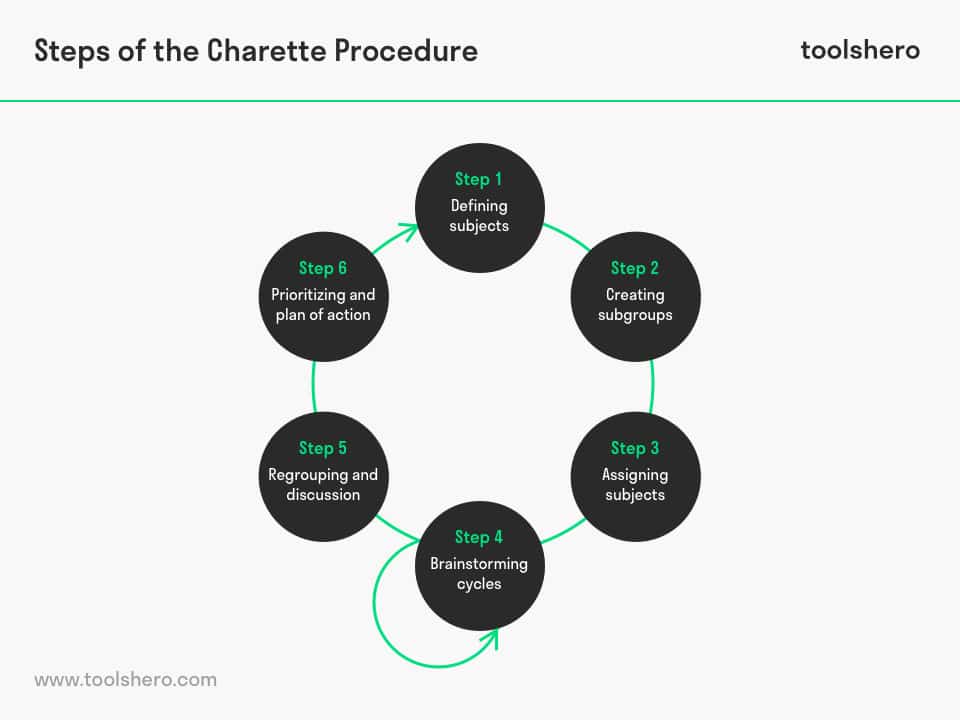Charette Procedure

Charette Procedure: this article describes the Charette Procedure method in a practical way. After reading you will understand the definition, meaning and basics of this powerful brainstorming and creativity tool.
What is the Charette Procedure?
The Charette Procedure enables a large group of people to think about one or more ideas and helps them all to form an opinion. It comes from the French word ‘charrette’, meaning ‘cart’.
In the 19th century, architecture students would use little carts to get their drawings from one place to another quickly, in order to get approval for their work. The Charette Procedure works exactly the same way.
The ideas that have been generated by one group are send to the other group, allowing that group to think about it too and refine the earlier ideas.
The Charette Procedure and large groups
The Charette Procedure is a type of brainstorming. It can offer a solution for problems regarding one or more topics that have to be solved simultaneously. It helps keep the process on track in the hopes of achieving a successful result.
This method works particularly well if the group consists of a large number of people. Brainstorming sessions with more than 10 people tend to get out of hand; let alone sessions where multiple problems need to be addressed.
Usually, such meetings are dominated by a small number of people and more passive employees barely say anything. The Charette procedure enables everyone to contribute to the discussion.
The Charette Procedure method prevents discussions from getting bogged down. During each round, everyone is given equal opportunity to participate. The Charette Procedure can be used when:
- Multiple topics will be discussed
- A large group of people is involved with the discussion (think of 10 to 30 people)
- There is limited time to address all topics
- It’s important that everyone contributes to the discussion
Charette Procedure, the approach
In the Charrette Procedure, the large group is divided into smaller groups of for instance five people. The number of subgroups depends on the number of topics that will be discussed.
If it’s four topics, then each group will get one topic to discuss and generate ideas about. The collected ideas are subsequently handed over to the next group for them to think about.
Like that, the topic and idea suggestions go from group to group to be discussed. The same happens for the other topics. By the end, all final ideas are collected, analysed and prioritised. That way, the search for the best solutions can start.
Recorder
An important role during the Charette Procedure is that of ‘recorder‘. This person acts as chairman and ensures that the brainstorming sessions stays on track.
He facilitates the entire meeting, ensures that the problems have been clearly defined and divides the group into subgroups. The recorder physically goes from group to group, keeps the discussion going, monitors the time and delivers the ideas to the next group.
In addition, his task is also to record the discussions that are taking place. The Charette Procedure is complete when all topics have made the rounds past all subgroups and the recorder has collected all the ideas. The following steps can help to guide the process:
Step 1: defining subjects
The recorder comes to an agreement with the groups about the problems that will be discussed.
Step 2: creating subgroups
The recorder divides the group into smaller subgroups with a maximum number of seven people. It’s good to form diverse groups, so that different skill sets make a contribution and creativity is encouraged.
Step 3: assigning subjects
The recorder assigns a problem to each subgroup and possibly lets each subgroup choose its own recorder to collect and record ideas.
Step 4: brainstorming cycles
The discussions start and the recorder monitors how much time the groups have to discuss the topic. He then collects the ideas from the first group and hands them to the second, which will then start working on it. In that fashion, he assigns ideas per group and then passes them on to the next group.
Step 5: regrouping and discussion
When all topics have been discussed by all subgroups and sufficient ideas have been generated, the entire group comes together. Led by the recorder, they discuss the results for each topic. At this stage, the ideas are sorted and divided into good and not-so-good ideas.
Step 6: prioritizing and plan of action
Based on the ideas that have been offered, grades are assigned and priorities are set. That makes it easy to come up with a plan of action based on the filtered ideas. Democratic decision making can help to prioritise the required actions.
The Charette Procedure in practice
The Charette Procedure is relatively easy to use. Depending on the topic, different group discussions can be held on a single day. The best results do require thorough preparation.
A recorder has to be appointed in advance, and it’s also a good idea to appoint a recorder per subgroup who will record their ideas. That’s not a requirement though.
If the number of groups is larger than the number of topics, you can give two groups the same topics and let them discuss it separately. Usually, 10 minutes per topic is enough time to generate ideas.
Now it’s Your Turn
What do you think? Is the Charette Procedure applicable in your daily work? What is your experience with with this and other Brainstorming techniques? Do you recognize the practical explanation or do you have more additions?
Share your experience and knowledge in the comments box below.
More information
- Cory, T. R. (2003). Brainstorming: Techniques for new ideas. iUniverse.
- Kovach, J. V. (2016). The Role of Learning and Exploration in Quality Management and Continuous Improvement. In Quality in the 21st Century (pp. 75-89). Springer, Cham.
- Park-Gates, S. L. (2001). Effects of group interactive brainstorming on creativity (Doctoral dissertation, Virginia Tech).
How to cite this article:
Mulder, P. (2018). Charette Procedure. Retrieved [insert date] from Toolshero: https://www.toolshero.com/creativity/charette-procedure/
Published on: 04/05/2018 | Last update: 08/22/2022
Add a link to this page on your website:
<a href=”https://www.toolshero.com/creativity/charette-procedure/”>Toolshero: Charette Procedure</a>













